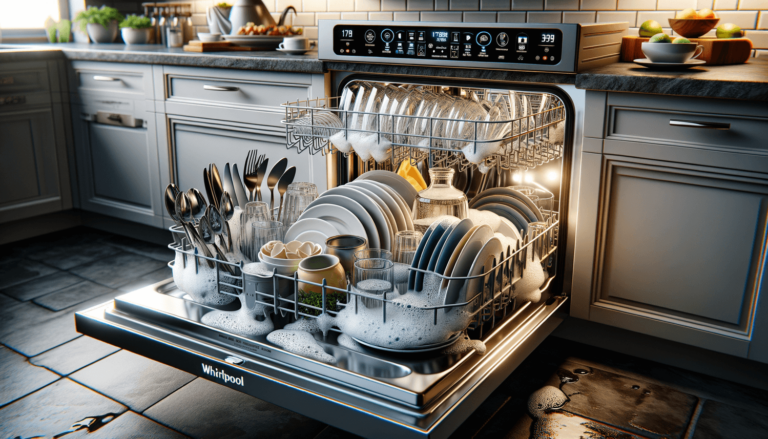

Welcome to our comprehensive guide on Whirlpool dishwasher settings! In this blog post, we’ll break down each feature and setting to help you optimize your dishwasher’s performance, and effectively clean every dish you throw its way. Get ready to understand and customize your Whirlpool dishwasher like never before!
In this post, we’ll dive into Whirlpool dishwasher settings, detailing each option to enable you to run the dishwasher efficiently and achieve spotless dishes. Let’s swiftly unlock your Whirlpool dishwasher’s full potential!
Whirlpool dishwashers come with various preset cycles and options to provide the best possible cleaning experience. By learning the ins and outs of these dishwasher settings, you can ensure spotless dishes every time.
The Sensor Cycle uses advanced technology to automatically detect soil levels on your dishes and adjusts the cycle accordingly. This means you can load your dishwasher with confidence, without pre-selecting settings, and still achieve exceptional results.
Need clean dishes fast? The 1-Hour Wash cycle is designed for lighter loads and delivers sparkling results in just an hour. It’s an efficient option for those who prefer frequent, quick washes instead of waiting to fill the dishwasher completely.
Designed for heavily-soiled pots, pans, and cookware, the Heavy Cycle uses increased water pressure and high temperatures to deal with stubborn, baked-on food residue. It’s the go-to option when regular dishwasher settings just aren’t enough.
Perfect for everyday use, the Normal Cycle cleans moderately-soiled dishes, glassware, and silverware. This cycle balances time, water, and energy usage to provide the best overall performance for regular loads.
If you have a load filled with lightly-soiled dishes and glassware, the Light Cycle uses less water and a shorter wash time. This efficient option saves on water and electricity while still delivering clean dishes.
The Sanitize Option can be added on to any of the mentioned cycles. This feature raises the water temperature during the final rinse, killing 99.999% of bacteria and improving your dishes’ drying performance.
The Heated Dry option utilizes an internal heating element to speed up the drying process. By selecting this feature, you’ll reduce the need to towel-dry your dishes after the cycle is complete.
The Delay Start feature allows you to set your dishwasher’s run time up to 24 hours in advance. This is a convenient option if you want to take advantage of off-peak energy hours or avoid running your dishwasher during busy household moments.
Armed with this knowledge of Whirlpool dishwasher settings, you’re ready to tackle any dishwashing challenge. Customize your dishwasher’s performance to your specific needs and enjoy spotless, sanitized dishes in no time.
While understanding the core dishwasher settings is essential, we believe that applying some additional tips will help you unlock your Whirlpool dishwasher’s true potential. At Settings King, we consistently strive to help users make the most of their technology settings, and dishwashers are no exception. Here are some expert pointers for improving your dishwasher experience.
Many people feel the need to pre-rinse their dishes before loading them into the dishwasher. While it’s true that you should scrape off large food particles before loading, excessively rinsing your dishes might cause the Sensor Cycle to underestimate the required wash intensity. So, save water and time by relying on the dishwasher to do its job!
Properly loading your dishwasher ensures effective cleaning and avoids potential damage to your dishes. Place plates and larger items like pots and pans on the bottom rack, angled towards the center, while glasses and smaller items secure on the top rack. Don’t overcrowd your dishwasher, as that can restrict water flow and prevent some dishes from getting clean.
The quality of dishwasher detergents and rinse aids plays a crucial role in the overall cleanliness of your dishes. Don’t skimp on quality. Investing in high-quality detergents with enzymes and rinse aids will not only contribute to your dishwasher’s performance but also prolong its lifespan. At Settings King, we recommend researching and selecting products that meet your dishwasher’s specifications and suit your needs.
By combining a deep understanding of Whirlpool dishwasher settings with these insider tips, you’re well on your way to becoming a master of your dishwashing domain. Keep these pointers in mind, and you’ll be well-equipped to handle any dishwashing challenge while reducing your environmental footprint.
After reading our guide on Whirlpool dishwasher settings, you may have some additional questions. We’ve gathered five common questions and provided succinct answers to further assist you in understanding your dishwasher and optimizing its performance.
The Light Cycle uses less water and energy, making it the most efficient option for lightly-soiled dishes. This cycle is not suitable for heavily-soiled loads, as the cleaning performance may be compromised.
No, you don’t need to use the Heated Dry setting for every cycle. If you’re not in a hurry, you can save energy by letting your dishes air-dry. Simply open the dishwasher slightly after the cycle finishes, allowing air to circulate and dry the dishes naturally.
Yes, the Sanitize Option can be added to any cycle, including Heavy, Normal, and Light. The increased water temperature during the final rinse will help to kill 99.999% of bacteria and improve the drying performance of your dishes.
First, ensure that the Heated Dry setting is activated. If dishes are still wet, make sure you’re using a rinse aid. Rinse aids help improve drying performance by reducing water spots and helping water to roll off the dishes more efficiently.
If you have hard water, you may need to use more detergent or consider using a water softener to improve the dishwasher’s performance. Additionally, using a dishwasher cleaner regularly can help maintain your appliance and prevent hard water buildup.